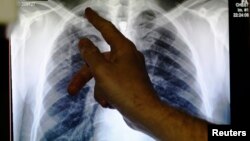Researchers have developed a new way of diagnosing tuberculosis. The new DNA-based test has advantages over 19th century diagnostic methods that are still in use.
Tuberculosis is an infectious disease that is especially common in low- and middle-income countries. The World Health Organization says it kills more than a million people a year.
The diagnosis of tuberculosis hasn’t changed much since the 1880s. A sputum specimen coughed up by the patient is examined under a microscope, and suspected TB bacteria is grown in the laboratory. It’s a time-consuming process, taking several weeks or more.
Now, Professor Mark Pallen from Britain’s University of Warwick describes a new process that can shorten the time dramatically by identifying strands of tuberculosis DNA in a sputum sample.
“We’re talking about three days to go from getting the sputum sample, getting the DNA out of it, and then getting the sequence sorted. That’s the kind of measure that we’re looking at,” said Pallen.
And that speed is important because the sooner you have a diagnosis, the sooner you can start treatment.
The DNA-based diagnosis also can identify which particular strain of tuberculosis the patient has, including ones that have developed resistance to anti-TB drugs.
“And knowing that you have drug resistance as early as possible helps you to treat the patient effectively. And the other thing is the treatment, once it’s started, fairly quickly if it’s appropriate treatment, will actually stop the patient being infectious, and so you can prevent forward transmission of the infection from that patient," he said.
The DNA sequencing required is still fairly expensive, but Pallen said costs rapidly are coming down.
“And so, the idea that you might be able to do this kind of thing in a resource-poor setting ... I think we can see that on the horizon. It’s not a completely fanciful idea," he said.
The paper published by Pallen and his colleagues in the journal PeerJ describes a proof-of-concept experiment using just a handful of specimens collected from patients in Gambia. Pallen said his lab’s next goal is to refine the procedure and then move on to a large-scale test.






